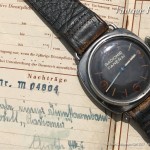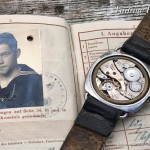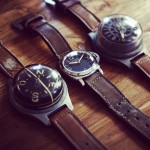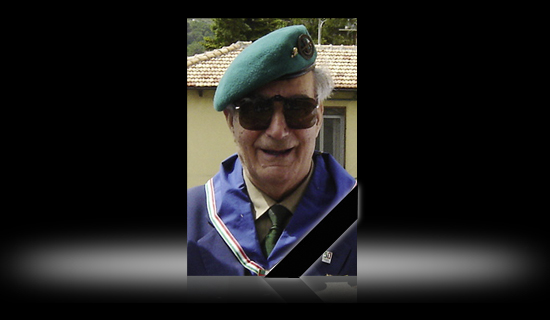Allgemein
New in our database: A Ref. 3646 / Type B “Radiomir Panerai”
by Volker on May.24, 2017, under Allgemein
 Another Ref. 3646 / Type B watch with “Radiomir Panerai” sandwich dial has been added into our database. The actual owner of the watch provided us further information on the first owner with the very rare ID of the german frogman Robert E., dating back to the last months of the Second World War.
Another Ref. 3646 / Type B watch with “Radiomir Panerai” sandwich dial has been added into our database. The actual owner of the watch provided us further information on the first owner with the very rare ID of the german frogman Robert E., dating back to the last months of the Second World War.
The watch appears with its original leather strap and nickel-plated brass pin buckle. The inner caseback bears the typical Rolex hallmark, case and reference number, known in watches of the Ref. 3646 / Type B as well as the Rolex Cal. 618 / Type 1 movement. The initial Rolex screw-down crown has been replaced with the crown mounted on the watch, shown in the actual photos.
 At the age of 17, Robert E. posted to the Kommando der Kleinkampfverbände in February 1945. He took part at a special training course for frogmen and divers, held at a small Danish Island (see page 203 of our book “History1”) documented in his ID by the stamp “Kampfschwimmer- und Tauchlehrgang”.
At the age of 17, Robert E. posted to the Kommando der Kleinkampfverbände in February 1945. He took part at a special training course for frogmen and divers, held at a small Danish Island (see page 203 of our book “History1”) documented in his ID by the stamp “Kampfschwimmer- und Tauchlehrgang”.
Another signature in his ID is showing a stamp of the Kampfschwimmergruppe Ost (eastern combat swimmer group), to which he was posted after the training, dating back to April 1945.
A very interesting supplementary note can be found in his ID, hand written below the field post number: Ausgabe einer Dienstarmbanduhr Modell “Radiomir” confirming that a diving watch was issued to him for duty, even more mentioning the particular model being a “Radiomir”.
Rare documentation, such as an ID of a frogman, providing interesting information about which ways these watches took many years ago. Thanks to the owner for providing the additional info aside the details of the watch, being a new entry in our Vintage Panerai database!
“Trittico”
by Volker on May.03, 2017, under Allgemein
 Compass, watch and depth gauge made by Guido Panerai & Figlio: a “Trittico”. Huge and impressive instruments worn on the wrist. Compasses, watches of the Ref. 6152/1 and depth gauges are featured in several versions (with “Radiomir” and “Luminor” luminous material) in the chapters VIII.II, XI.I and XI.II of the second volume of our book “The References”.
Compass, watch and depth gauge made by Guido Panerai & Figlio: a “Trittico”. Huge and impressive instruments worn on the wrist. Compasses, watches of the Ref. 6152/1 and depth gauges are featured in several versions (with “Radiomir” and “Luminor” luminous material) in the chapters VIII.II, XI.I and XI.II of the second volume of our book “The References”.
Chapter VIII.II is about the watches of the Ref. 6152/1 with crown-protecting device and Rolex movement and holds information about nine different models (page 922 to 1057) with “Marina Militare”, “Radiomir Panerai” and “Luminor Panerai” dials (as shown in the photo). Chapter XI.I is about compasses from Guido Panerai & Figlio. Five different models are featured from page 1320 to 1333. Three with “Radiomir”, two with “Luminor” dials. Chapter XI.II is featuring depth gauges. Ten different models are featured from page 1334 to 1367. Six with “Radiomir” dials, aimed to 7, 30, 35 (2 versions: adjustable and non-adjustable dial), 50 and 60 meters. Four with “Luminor” dials, aimed to 7, 15, 16, 30 and 40 meters. Last but not least, chapter XII gives an overview of the straps and buckles used on watches and instruments from Guido Panerai & Figlio in this era.
Information on “The References” 1950’s-1960’s can be found here.
Arrivederci, Isidoro Mario Nardin
by Volker on Apr.26, 2017, under Allgemein
 Sad news from Italy reached us today: Isidoro Mario Nardin, WW2 veteran of the “Gruppo Gamma”, passed away earlier this year, 27 February 2017, at the age of 94. We send our belated condolences to his family.
Sad news from Italy reached us today: Isidoro Mario Nardin, WW2 veteran of the “Gruppo Gamma”, passed away earlier this year, 27 February 2017, at the age of 94. We send our belated condolences to his family.
We first met Isidoro Mario Nardin in person back in 2006 when he was proudly showing his watch to us. Eight years later, and with the valueble support of Paolo Ferraro, the son of Luigi Ferraro M.O.V.M., it was possible to contact Isidoro Mario Nardin (the third owner of the Ref. 3646 / Type C which initially belonged to Licio Visintini M.O.V.M.) to be able to present the watch in detail in chapter II.III of our book “The References”.

Beside many photos of the watch with the engraved caseback bearing the three names of its owners (see above page 358-359), a historic photo from 1946 showing Isidoro Mario Nardin in full diving gear, is closing the chapter on watches of the Ref. 3646 / Type C (see below page 396-397).

“Arrivederci!” Sig. Nardin, rest in peace!
[Ralf Ehlers & Volker Wiegmann]
One more engraved Ref. 3646 / Type B with “Radiomir Panerai” dial surfaced
by Volker on Mar.20, 2017, under Allgemein
 You never know how long it takes until a “new”, yet unknown watch surface after many years. This happened quickly twice in the last weeks, with another addition into our database in shape of a Ref. 3646 / Type B with “Radiomir Panerai” sandwich dial and completely engraved “Kampfschwimmer” caseback.
You never know how long it takes until a “new”, yet unknown watch surface after many years. This happened quickly twice in the last weeks, with another addition into our database in shape of a Ref. 3646 / Type B with “Radiomir Panerai” sandwich dial and completely engraved “Kampfschwimmer” caseback.
Different to the Ref. 3646 / Type C with riveted plastic dial introduced earlier here (which included a month-lasting research for the family of the frogman), this rare Ref. 3646 / Type B “Radiomir Panerai” watch was introduced to us by the grandson of the frogman. Complete with the original strap and nickel-plated brass buckle, the watch with the small Oyster Watch Co hallmark on its inner caseback appears after 72 years with the original domed plexiglas, onion shaped “Brevet +” crown (Type 11) and Rolex Cal. 618 / Type 1 movement.
 The caseback of the watch bears the initials “HE” of the first owner. The frogman belonged to the “Einsatzgruppe Heyden” which is engraved around the word “Kampfschwimmer” and the year of service, 1945. Lieutenant-Commander Günter Heyden was a founding member of the newly formed German commando frogmen (Kommando Spezialkräfte Marine) in the 1950’s.
The caseback of the watch bears the initials “HE” of the first owner. The frogman belonged to the “Einsatzgruppe Heyden” which is engraved around the word “Kampfschwimmer” and the year of service, 1945. Lieutenant-Commander Günter Heyden was a founding member of the newly formed German commando frogmen (Kommando Spezialkräfte Marine) in the 1950’s.
The watch is accompanied with historic photos of the veteran as well as a very rare pay book (silmiar to only two others known which are made of the same material, see page 138 in our book “History1”) and which was issued to the members of the “Lehrkommando 700″ in the last months of the Second World War. Not enough rarity, there is a swordfish probation insignia (see page 802-804 in our book “History2”) and a nose clip which was used by the frogmen during the use of a small breathing apparatus (without face mask, see page 671 of our book “The References” 1930’s-1940’s and page 718 of our book “History2”).
Watches of the Ref. 3646 / Type B are featured in our book “The References” (first volume / 1930’s-1940’s) in chapter II.II on page 170-247.
Surfaced after 72 years: one more Ref. 3646 / Type C with riveted plastic dial
by Volker on Mar.19, 2017, under Allgemein
When we started to search for the veteran at the beginning of 2017, we could not know wether the search would be successful or not (like many times before). We knew the frogman only by his name, featured in battlefield reports since the mid 1950’s several times, and we knew the city in Germany where he lived after the end of the Second World War.
When we virtually knocked at his door, nobody was there to open anymore. With a big portion of luck and the cooperation of his family, we connected a few months later to finally ask his family some questions, which the veteran himself was sadly not able to answer anymore. We provided some photos of the German “Kampfschwimmer” from 1944 and 1945 to the family, which they had never seen before, but which were part of our records since several years.
 Recently we got photos of the Vintage Panerai watch, which the frogman stored in a safe place before the war was over and before he became a POW of the British. Before we saw the first photos, our “wild guess” was, that it could be a Ref. 3646 / Type D. But the soon later arrived photos of the dial let us think it might be an earlier version: a 3646 with riveted plastic dial. Maybe it would be a Ref. 3646 / Type B like most of the watches with such dials are recorded? The final proof to which number group it belongs to, was the look onto the inner caseback of the watch: a Ref. 3646 / Type C with Rolex SA hallmark in the center and a seven digit number underneath the reference number 3646. So, one more piece of the Vintage Panerai puzzle added in shape of a Ref. 3646 / Type C with riveted plastic dial.
Recently we got photos of the Vintage Panerai watch, which the frogman stored in a safe place before the war was over and before he became a POW of the British. Before we saw the first photos, our “wild guess” was, that it could be a Ref. 3646 / Type D. But the soon later arrived photos of the dial let us think it might be an earlier version: a 3646 with riveted plastic dial. Maybe it would be a Ref. 3646 / Type B like most of the watches with such dials are recorded? The final proof to which number group it belongs to, was the look onto the inner caseback of the watch: a Ref. 3646 / Type C with Rolex SA hallmark in the center and a seven digit number underneath the reference number 3646. So, one more piece of the Vintage Panerai puzzle added in shape of a Ref. 3646 / Type C with riveted plastic dial.
The remarkable “untouched” condition, since it was keepsake for the veteran and has remained in the possession of the frogman’s family during all these years (72 years, to be exactly), can be pointed out by the fact that the watch has still the original leather strap sewn onto the soldered lugs of the cushion shaped case and the nickel-plated brass buckle (in the typical “bottle opener” shape with sharp edges) as well as a Rolex 618 / Type 1 movement with details known in more than 90% of all recorded watches of the Ref. 3646 / Type C in our database. The still complete luminous material on the blued steel hands can be rarely found on watches of this age, as well as the original domed plexi and the onion shaped crown (“Brevet +” / Type 11). More about watches of the Ref. 3646 / Type C can be found in our book “The References” 1930’s-1940’s on page 248-397 in chapter II.III.
We hope that the watch remains as a keepsake for the family and maybe the veteran’s grandchildren enjoy wearing it in the future. [Ralf Ehlers & Volker Wiegmann]
“Marina Militare” on the front and back of a Ref. 6152/1
by Volker on Mar.18, 2017, under Allgemein
 Of the less than 70 registered watches of the Reference 6152/1 with Rolex movement and crown-protecting device, almost a third feature a “Marina Militare” dial. The specimen shown here was a new entry into our database in 2016, which is also engraved on the caseback with the “long version” marking Sommozzatori Marina Militare, together with a three-digit number (S.M.Z. M.M. XXX). Less than fourty casebacks with such a matriculation number are recorded in our database until today, used on both, Ref. 6152/1 watches with 8 mm Rolex crown and Ref. 6152/1 with the crown-protection device from Guido Panerai & Figlio, no matter which movement is inside (Rolex or Angelus).
Of the less than 70 registered watches of the Reference 6152/1 with Rolex movement and crown-protecting device, almost a third feature a “Marina Militare” dial. The specimen shown here was a new entry into our database in 2016, which is also engraved on the caseback with the “long version” marking Sommozzatori Marina Militare, together with a three-digit number (S.M.Z. M.M. XXX). Less than fourty casebacks with such a matriculation number are recorded in our database until today, used on both, Ref. 6152/1 watches with 8 mm Rolex crown and Ref. 6152/1 with the crown-protection device from Guido Panerai & Figlio, no matter which movement is inside (Rolex or Angelus).
This 6152/1 is powered by a Rolex 618 / Type 4 movement, which can be found in more than 80% of all Ref. 6152/1 watches, recorded in our database until today (Type 4 = 17 Rubis and Incabloc shock protection.
Find information about the different matriculation numbers on Ref. 6152/1 watches in our book “The References” 1950’s-1960’s in chapter VIII.I (page 913-917). Watches of the Reference 6152/1 with Rolex movement and crown-protecting device can be found in chapter VIII.II (page 922-1057).
A rare bird surfaced – in shape of a Ref. 6152/1 with C.C. engraved caseback
by Volker on Mar.13, 2017, under Allgemein
 Introducing another piece of the Vintage Panerai puzzle – and one more from the watches, which were used by the Carabinieri, bearing a rare engraving on its caseback. Until today we have recorded only seven Ref. 6152/1 in our database with C.C. engraving and matriculation number on their casebacks.
Introducing another piece of the Vintage Panerai puzzle – and one more from the watches, which were used by the Carabinieri, bearing a rare engraving on its caseback. Until today we have recorded only seven Ref. 6152/1 in our database with C.C. engraving and matriculation number on their casebacks.
Beside this watch, four similar specimen with “Luminor Panerai” dial and crown-protecting device are part of our database. The new owner has recently provided photos and informations, after purchasing the watch from the family of a Carabinieri veteran, for our records.
 More than 50% of all recorded Ref. 6152/1 watches with crown-protecting device bear a “Luminor Panerai” dial. Inside the watch works a Rolex Cal. 618 / Type 4 movement which is known in more than 80% of all Ref. 6152/1 watches, recorded in our database until today.
More than 50% of all recorded Ref. 6152/1 watches with crown-protecting device bear a “Luminor Panerai” dial. Inside the watch works a Rolex Cal. 618 / Type 4 movement which is known in more than 80% of all Ref. 6152/1 watches, recorded in our database until today.
Read more about watches with C.C. engraving on page 964-971 in our book “The References” 1950’s-1960’s. Read also more on Vintage Panerai watches with engraved matriculation numbers here.
Evolution.
by Volker on Feb.18, 2017, under Allgemein
 The evolution of Vintage Panerai watches from Guido Panerai & Figlio from the 1930’s to the 1960’s can be symbolized in a photo like the one shown here: from a cushion shaped case with soldered lugs and an onion shaped crown to a much stronger, massive case with solid lugs and the legendary crown-protecting device.
The evolution of Vintage Panerai watches from Guido Panerai & Figlio from the 1930’s to the 1960’s can be symbolized in a photo like the one shown here: from a cushion shaped case with soldered lugs and an onion shaped crown to a much stronger, massive case with solid lugs and the legendary crown-protecting device.
The early References 2533 (chapter I) and 3646 (chapter II) are explained and with rich reference to several variants by their number groups in the first volume “The References” 1930’s-1940’s. This overview is complimented by the legendary Mare Nostrum chronograph (chapter III), rare compasses (chapter IV) used in the Second World War and some of the few straps and buckles which rarely survived after more than 70 years (chapter V). Find information about the content of our book “The References” 1930’s-1940’s by using the “browse by tag” function. The tag 696 is connected with all stories published about the first volume: watches, history, instruments and straps of the 1930’s-1940’s.
“The References” 1950’s-1960’s features numerous images and historic information on Vintage Panerai watches from the 1950’s to 1960’s. The References 6152 (chapter VI) and 6154 (chapter VII), are followed by Reference 6152/1 with the famous crown-protecting device are explained in detail and many variations in chapter VIII. Followed by the Reference GPF 2/56 with Angelus movement (chapter IX), “The References” 1950’s-1960’s features in chapter X the Modified References 3646, Transitional 3646 and Modified Reference 6152/1. Chapter XI is about compasses and depth gauges, followed by the last chapter XII, an overview of the straps and buckles used on watches and instruments from Guido Panerai & Figlio in this era. Find information about the content of our book “The References” 1950’s-1960’s by using the “browse by tag” function. The tag 1392 is connected with all stories published about the second volume: watches, history, instruments and straps of the 1950’s-1960’s.
 “The References” 1930’s-1940’s
“The References” 1930’s-1940’s
Embossed hardback jacket (leather and canvas), slipcase,
696 pages, five chapters, trilingual
(German, English and Italian language)
“The References” 1950’s-1960’s
Embossed hardback jacket (leather and canvas), slipcase,
696 pages, seven chapters, trilingual
(German, English and Italian language)
The spine of our both “The References” books are embossed with the symbols of evolution, just like the first photo above shows it at a glance: from a cusion shaped case with soldered lugs and an onion shaped crown (“The References” 1930’s-1940’s) to a much stronger, massive case with solid lugs and the legendary crown-protecting device (“The References” 1950’s-1960’s). Visit our bookstore and enjoy reading soon!
[Ralf Ehlers & Volker Wiegmann]
Panerai depth gauge, worn by the Col. Moschin Special Forces
by Volker on Feb.02, 2017, under Allgemein
 Spotted! The historic photo on the left shows two members of the Col. Moschin (Special Forces of the Italian Army / 9º Battaglione Paracadutisti d’Assalto “Col Moschin”). A depth gauge from Guido Panerai & Figlio can be clearly seen on the wrist of the right incursore, holding diving equipment in his left hand.
Spotted! The historic photo on the left shows two members of the Col. Moschin (Special Forces of the Italian Army / 9º Battaglione Paracadutisti d’Assalto “Col Moschin”). A depth gauge from Guido Panerai & Figlio can be clearly seen on the wrist of the right incursore, holding diving equipment in his left hand.
Compasses and depth gauges made by Guido Panerai & Figlio are featured in several versions (with “Radiomir” and “Luminor” luminous material) in chapter XI of the second volume of our book “The References”. Chapter XI.I is featuring compasses from Guido Panerai & Figlio. Five different models are featured from page 1320 to 1333. Three with “Radiomir”, two with “Luminor”. Chapter XI.II is featuring depth gauges from Guido Panerai & Figlio, similiar to the instrument which can be seen in the photo. Ten different models are featured from page 1334 to 1367. Six with “Radiomir”, aimed to 7, 30, 35 (2 versions: adjustable and non-adjustable dial), 50 and 60 meters. Four with “Luminor”, aimed to 7, 15, 16, 30 and 40 meters.
Information on “The References” 1950’s-1960’s (second volume) can be found here.
Click ‘1392’ to find info on “The References” 1950’s-1960’s at a glance
by Volker on Jan.14, 2017, under Allgemein
 Find information about the content of our book “The References” 1950’s-1960’s by using the “browse by tag” function. The tag 1392 is connected with all stories published about the second volume: watches, history, instruments and straps of the 1950’s-1960’s.
Find information about the content of our book “The References” 1950’s-1960’s by using the “browse by tag” function. The tag 1392 is connected with all stories published about the second volume: watches, history, instruments and straps of the 1950’s-1960’s.
“The References” 1950’s-1960’s features numerous images and historic information on Vintage Panerai watches from the 1950’s to 1960’s. The References 6152 (chapter VI) and 6154 (chapter VII), are followed by Reference 6152/1 with the famous crown-protecting device are explained in detail and many variations in chapter VIII (a Ref. 6152/1 with Rolex movement and crown-protecting device can be seen in the photo on the left, see chapter VIII.II. The watch is placed on a historic photo of a special tank made by Guido Panerai & Figlio, see also page 714). Followed by the Reference GPF 2/56 with Angelus movement (chapter IX), “The References” 1950’s-1960’s features in chapter X the Modified References 3646, Transitional 3646 and Modified Reference 6152/1. Chapter XI is about compasses and depth gauges, followed by the last chapter XII, an overview of the straps and buckles used on watches and instruments from Guido Panerai & Figlio in this era.
“The References” books are in stock and ready for shipping – just visit our bookstore and enjoy reading soon! [Ralf Ehlers & Volker Wiegmann]





